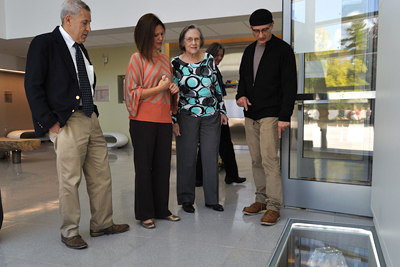Time capsule to be opened in 2065 preserves Cornell history
By Sarah Cutler


College magazines, Cornell course catalogs, food and gasoline receipts, electronic devices -- all these items and more are sealed in a time capsule designed by a Cornell professor and permanently under glass in the floor of the lobby of the Human Ecology Building.
Though it won't be opened until 2065, the bicentennial of Cornell's founding, the aluminum vessel, about 10 feet long and weighing 50 pounds, looks like something from the distant future. Designer Jack Elliott, associate professor of design and environmental analysis, intended it to have "an otherworldly quality."
"It's a wild architectural feature [of the building]," Elliott said. "It reminds me of Snow White's casket, of suspended animation -- this idea of the past, kept in a preserved state."
Over the course of a month, Elliott and a team of undergraduate research assistants made solid models of the design and then worked with Ithaca machine shop Bennett Die and Tool to carve pieces of the capsule using a sophisticated metal fabricator. The rhombus- and triangle-oriented aluminum design, which Elliott began considering in April 2010, is based on the number five. It features five interconnected pentagon-shaped nodes, each with about five basketballs' worth of volume.
The number five signifies the college's major academic departments. But as students and faculty members collected materials to preserve in the capsule, the number also came to stand for the college itself, Cornell, Ithaca, the nation and the world, leading them to select items representing each.
"We wanted to define what Human Ecology is to the community, so the project became broader," said Senior Associate Dean Kay Obendorf, who oversaw the team that gathered materials for the capsule. "This was a very interesting experience, to see the breadth of what affects our life, past and present, and where this university is going."
From the mundane -- Martha's Café receipts, a compostable spoon -- to the historic -- memorabilia from the Martha Van Rensselaer North building, which closed in 2001 -- the contents of the capsule are intended to tell a story about the college's history as well as life in the early 21st century. The capsule contains books used and written by faculty, as well as the course catalog from 2010, the last year it was available in print. There are also course syllabi and posters for campus events.
To capture what student life was like, about a dozen students collected fashion magazines, movies, books -- including the "Twilight" series -- USB drives, cell phones and more.
"We're affected by everything, not just by our school, and we wanted to represent that," said Justine Dupal '10, one of the project's student leaders, along with Thomas Levine '11.
They wanted to depict "all sides of student life," including the recreational side, Dupal said. They gathered, for instance, photos showing fashion trends among students and a report about which drugs were on the rise and which were on the decline.
"Cornell students are exceptional academically but are still college students," she said. "We thought it would seem biased to not include the social elements of life at Cornell."
Although the capsule items were collected by Commencement 2011 and the building opened in fall 2011, construction for the time capsule's case took another year; the time capsule was installed Sept. 27.
This isn't the first time capsule at Cornell, but it's the first one exposed to the public.
"I wanted something not of the present," Elliott said. "It's meant to be strange. I wanted to disconnect it from the familiar, from a style, from a time, as it is time that it is meant to transcend."
Sarah Cutler '16 is a student communications assistant for the College of Human Ecology.
Media Contact
Get Cornell news delivered right to your inbox.
Subscribe